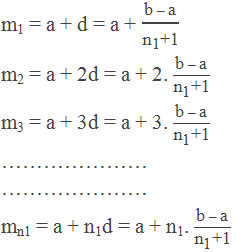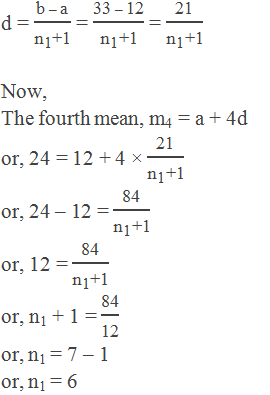.png)
If three numbers a, b and c are in Arithmetic Sequence (AS) then
the middle term b is said to be the arithmetic
mean (AM) between the other two. For example, 10, 14 and 18 are in AS, so
14 is the arithmetic mean between 10 and 18. If any number of terms are in AS
then the terms between the first and the last terms are known as the arithmetic
means between the first and the last. For example, 11, 14, 17, 20, 23, 26, 29,
32 are in AS, so 14, 17, 20, 23, 26, 29 are the arithmetic means between 11 and
32.
Arithmetic Mean Between Two Numbers
Let M be the arithmetic mean between two numbers a and b, then
a, M, b are in AS. Now by the definition of AS,
M – a = b – M
or, 2M = b + a

********************
10 Math Problems officially announces the release of Quick Math Solver and 10 Math Problems, Apps on Google Play Store for students around the world.
********************
********************
Arithmetic Means Between Two Numbers
Let m1, m2, ………, mn1 be the
arithmetic means between a and b, then a, m1, m2, ………, mn1,
b are in AS.
If d be the common difference, then
tn = a + (n – 1)d
As there are n1 + 2 terms in all i.e. n = n1
+ 2
b = a + (n1 + 2 – 1)d
or, b – a = (n1 + 1)d

Now, the required arithmetic means are,

Note: The second term of the sequence is the first mean and the third
term is the second mean and so on.
Worked Out Examples
Example 1: Find the arithmetic mean between 2 and 19.
Solution:
Here,
The first term (a) = 2
The last term (b) = 19
Arithmetic mean (AM) = ?
We know,

Example 2: If a, 30, b, 50, c are in AP, find the values of a, b and c.
Solution:
Here,
t1 = a, t2 = 30, t3 = b, t4
= 50, t5 = c
Now,
![t3 = ("t" _"2" "+" "t" _"4" )/"2" [as t3 is the mean of t2 and t4] or, b = "30+50" /"2" or, b = 40](https://blogger.googleusercontent.com/img/b/R29vZ2xl/AVvXsEhXK26EEJ4o0VNtdsDX5CQbjfvP2x0fI4NxPRQjz_2STAr2uKO-syWNt9Ycryw8-XnwEHYqZESp6mnWKbU-WJ8S-0C2dUF7kBdtfO84Q4HRts1lwTpUH3vTnHwfyypjvLjDSqHEply4PyYH4QOD-iy6cJ-KJWZL8m-NezlLAePqxMKXStJR9Zs81i-JQQ/s16000/example%202%20t3.png)
Again,
![t2 = ("t" _"1" "+" "t" _"3" )/"2" [as t2 is the mean of t1 and t3] or, 30 = "a+b" /"2" or, 30 = "a+40" /"2" or, a + 40 = 60 or, a = 60 – 40 or, a = 20](https://blogger.googleusercontent.com/img/b/R29vZ2xl/AVvXsEjWAHtyDU-KJ_FLTNWS30Z41YLB0IUf8SC1h3QjShXETxSEEatMKNX5UEzOBsBcKch_hEBt5-L6dbjnTBgOjDwV9VuHGO6I_9gXHJ_ql4Q-EvJU75byegWzO9gyAuudTT6gN2Xeg4T5_SejNGBBQGWNTFS2llUh5KVbfZVrNMSAvDeD2106z_uk_ghbdg/s16000/example%202%20t2.png)
Similarly,
![t4 = ("t" _"3" "+" "t" _"5" )/"2" [as t4 is the mean of t3 and t5] or, 50 = "b+c" /"2" or, 50 = "40+c" /"2" or, 40 + c = 100 or, c = 100 – 40 or, c = 60](https://blogger.googleusercontent.com/img/b/R29vZ2xl/AVvXsEhaO_O50kpEgX1BPqvQQtXbCewK0ibb6_Dv66H0-DcluA5_x9ZZ-EEtbQIEeQToTGWTDnkCmUOPI7RgU5D0rHt6nlVI0hqD3rqvOAhczYZWyGVlQe7oixYb1nTyhP--xfLWmu9wIQtH9YOE5zKlnyJ6VZWoqmWF4X4ve9qMlcrviI3dbNYlYAttp7Lb3w/s16000/example%202%20t4.png)
Hence, values of a, b and c are 20, 40 and 60 respectively.
Example 3: If 10, m + 5, ………, 3m, 35 are the terms of AP. Find the value of m.
Solution:
Here,
First term (a) = 10 = t1
Second term (t2) = m + 5
Second last term (tn – 1) = 3m
Last term (tn) = 35
We know that,
t2 – t1 = tn – tn – 1
or, m + 5 – 10 = 35 – 3m
or, m – 5 = 35 – 3n
or, m + 3m = 35 + 5
or, 4m = 40
or, m = 10
Thus, the value of m = 10. Ans.
Example 4: If there are 6 AM between 4 and 11, then find the common
difference.
Solution:
Here,
a = 4, b = 11 and number of means (n1) = 6
We know,

∴ The common difference d = 1. Ans.
Example 5: Insert 5 arithmetic means between 2 and 18.
Solution:
Here,
The first term (a) = 2
The last term (b) = 18
No. of means (n1) = 5
Hence, the common difference,

Hence, the required arithmetic means are,

Example 6: There are n1 arithmetic means between 12 and 33. If the
fourth arithmetic mean is 24, find the value of n1.
Solution:
Here,
The first term (a) = 12
The last term (b) = 33
The fourth mean (m4) = 24
No. of means (n1) = ?
We know,
Common difference,

∴ n1 = 6 Ans.
Example 7: There are n AM’s between 3 and 39. Find n so that the third mean :
the last mean = 3:7.
Solution:
Here,
The first term (a) = 3
The last term (b) = 39
No. of means = n
Third mean : last mean (m1:m2) = 3:7
The common difference,

Now,

∴ n = 8 Ans.
Example 8: The product of two numbers is 375 and their arithmetic mean is 20,
find the numbers.
Solution:
Let the numbers be a and b, the product of two numbers is 375
i.e. a × b = 375

their AM is 20,

or, a + b = 20 × 2
or, a + b = 40
Now, putting the value of a from (i), we get

or, 375 + b2 = 40b
or, b2 – 40b + 375 = 0
or, b2 – 25b – 15b + 375 = 0
or, b(b – 25) – 15(b – 25) = 0
or, (b – 25)(b – 15) = 0
∴ Either, b – 25 = 0 or, b = 25
Or, b – 15 = 0 or, b = 15

Hence, the required numbers are 15 and 25 or 25 and 15.
Example 9: One number is reciprocal to another and the arithmetic mean between
them is 5/4. Find those numbers.
Solution:
Let one number be x then the other number be 1/x

Hence, the required numbers are:




0 comments: